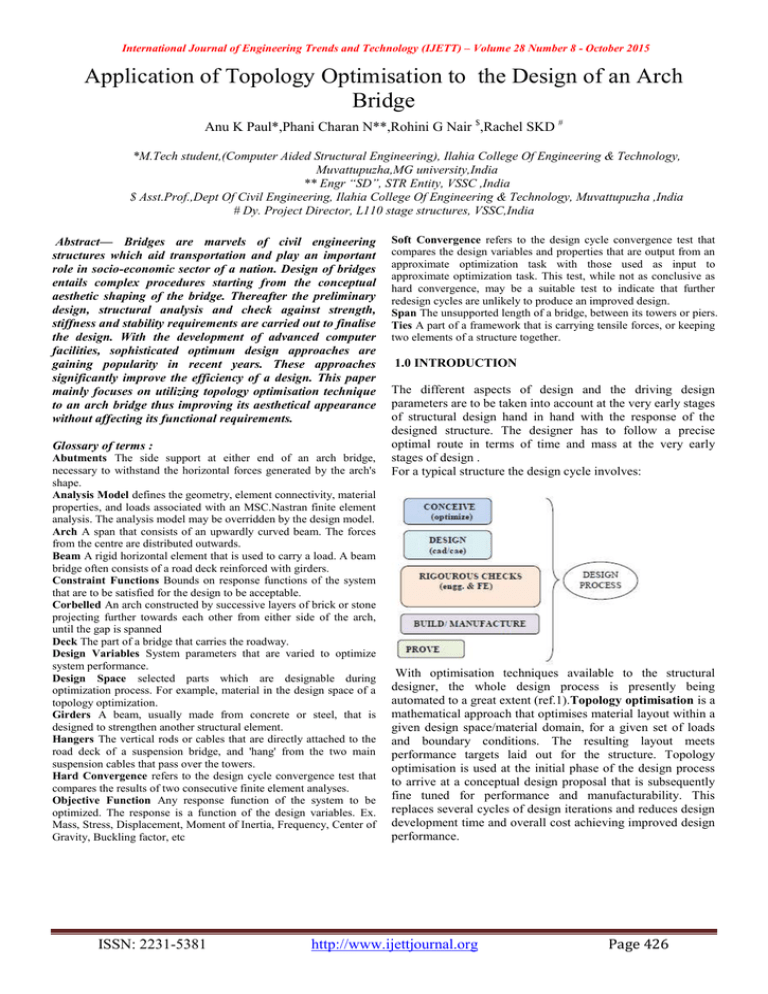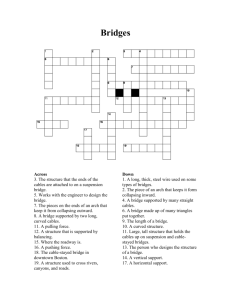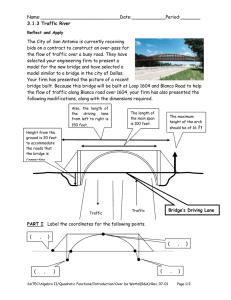Document 12915633
advertisement

International Journal of Engineering Trends and Technology (IJETT) – Volume 28 Number 8 - October 2015 Application of Topology Optimisation to the Design of an Arch Bridge Anu K Paul*,Phani Charan N**,Rohini G Nair $,Rachel SKD # *M.Tech student,(Computer Aided Structural Engineering), Ilahia College Of Engineering & Technology, Muvattupuzha,MG university,India ** Engr “SD”, STR Entity, VSSC ,India $ Asst.Prof.,Dept Of Civil Engineering, Ilahia College Of Engineering & Technology, Muvattupuzha ,India # Dy. Project Director, L110 stage structures, VSSC,India Abstract— Bridges are marvels of civil engineering structures which aid transportation and play an important role in socio-economic sector of a nation. Design of bridges entails complex procedures starting from the conceptual aesthetic shaping of the bridge. Thereafter the preliminary design, structural analysis and check against strength, stiffness and stability requirements are carried out to finalise the design. With the development of advanced computer facilities, sophisticated optimum design approaches are gaining popularity in recent years. These approaches significantly improve the efficiency of a design. This paper mainly focuses on utilizing topology optimisation technique to an arch bridge thus improving its aesthetical appearance without affecting its functional requirements. Glossary of terms : Abutments The side support at either end of an arch bridge, necessary to withstand the horizontal forces generated by the arch's shape. Analysis Model defines the geometry, element connectivity, material properties, and loads associated with an MSC.Nastran finite element analysis. The analysis model may be overridden by the design model. Arch A span that consists of an upwardly curved beam. The forces from the centre are distributed outwards. Beam A rigid horizontal element that is used to carry a load. A beam bridge often consists of a road deck reinforced with girders. Constraint Functions Bounds on response functions of the system that are to be satisfied for the design to be acceptable. Corbelled An arch constructed by successive layers of brick or stone projecting further towards each other from either side of the arch, until the gap is spanned Deck The part of a bridge that carries the roadway. Design Variables System parameters that are varied to optimize system performance. Design Space selected parts which are designable during optimization process. For example, material in the design space of a topology optimization. Girders A beam, usually made from concrete or steel, that is designed to strengthen another structural element. Hangers The vertical rods or cables that are directly attached to the road deck of a suspension bridge, and 'hang' from the two main suspension cables that pass over the towers. Hard Convergence refers to the design cycle convergence test that compares the results of two consecutive finite element analyses. Objective Function Any response function of the system to be optimized. The response is a function of the design variables. Ex. Mass, Stress, Displacement, Moment of Inertia, Frequency, Center of Gravity, Buckling factor, etc ISSN: 2231-5381 Soft Convergence refers to the design cycle convergence test that compares the design variables and properties that are output from an approximate optimization task with those used as input to approximate optimization task. This test, while not as conclusive as hard convergence, may be a suitable test to indicate that further redesign cycles are unlikely to produce an improved design. Span The unsupported length of a bridge, between its towers or piers. Ties A part of a framework that is carrying tensile forces, or keeping two elements of a structure together. 1.0 INTRODUCTION The different aspects of design and the driving design parameters are to be taken into account at the very early stages of structural design hand in hand with the response of the designed structure. The designer has to follow a precise optimal route in terms of time and mass at the very early stages of design . For a typical structure the design cycle involves: With optimisation techniques available to the structural designer, the whole design process is presently being automated to a great extent (ref.1).Topology optimisation is a mathematical approach that optimises material layout within a given design space/material domain, for a given set of loads and boundary conditions. The resulting layout meets performance targets laid out for the structure. Topology optimisation is used at the initial phase of the design process to arrive at a conceptual design proposal that is subsequently fine tuned for performance and manufacturability. This replaces several cycles of design iterations and reduces design development time and overall cost achieving improved design performance. http://www.ijettjournal.org Page 426 International Journal of Engineering Trends and Technology (IJETT) – Volume 28 Number 8 - October 2015 1.1. CATEGORIES OF ARCH BRIDGES Topology optimization in NASTRAN/PATRAN FE package used in this paper is based on the density method approach. The Density Method approach, alternatively called the Power Law approach or Artificial Material approach is based on the idea of convexification where an artificial material is used which is homogeneous. The density of the artificial material can vary between 0 and 1. This approach is simple and the optimum design consists of clear solids and voids. The homogenization approach has the advantage that the design can form rapidly along the lines of the force transmission path. Hence clear load and boundary definition at the very start of the optimization process is a necessity for topology optimisation. Topology optimization in NASTRAN/PATRAN FE package has a special TOPVAR Bulk Data entry to define the design variable/property relationship and two special responses - fractional mass response and mass target. A target mass fraction is used as a constraint in topology optimization task; (e.g., minimize the compliance of the structure while limiting the mass to 40% of the mass of the original structure). 1.1.1.Corbel Arch Bridge (ref.fig.1.1) The corbel arch bridge is a masonry or stone bridge where each successively higher course cantilevers slightly more than the previous course. The steps of the masonry may be trimmed to make the arch have a rounded shape. Fig 1.1. Corbel arch bridge (Source: http://wikipedia.org/wiki/files:Arkadiko2.jpg) 1.1.2.Deck Arch Bridge (ref.fig.1.2) This type of bridge comprises of an arch where the deck is completely above the arch. The area between the arch and the deck is known as the spandrel. [Stiffest structure = structure with minimal compliance Compliance is typically used as an objective in a topology optimization design task to maximize structural stiffness in a static design problem. Compliance C = f Tu = uT Ku; f is flexibility matrix, K is stiffness matrix, u is displacement vector]. The smoothed and final topologically optimized proposal obtained from the final design cycle is exported as an IGES file used by any CAD system. This is further used for shape optimization. In this paper the exercise of topology optimisation is attempted for an arch bridge design. Fig 1.2. Deck Arch Bridge(Harlem River Bridges -New York) (source:http://wikipedia.org/wiki/files:Harlem River Bridges) 1.1.3.Through Arch Bridge (ref.fig.1.3) The Sydney Harbor Bridge is a through arch bridge which uses a truss type arch. These through arch bridges are in contrast to suspension bridges which use the catenary in tension to which the cables or tie bars are attached and suspended. Fig.1 A typical arch bridge Arch bridges are one of the oldest types of bridges and have been around for thousands of years. Arch bridges are the most aesthetic and functional amongst all types of bridges; ref.fig.1.0. Long-span arch bridges over deep valleys are a rare site for a traveller be it on road/and or rail. Arch bridge have great natural strength. They were constructed from stone or brick in olden times but these days are built out of reinforced concrete or steel. The introduction of these new materials allows arch bridges to be longer with higher spans. Fig. 1.3. Through Arch Bridge (Sydney Harbor Bridge) (source :https://en.wikipedia.org/wiki/Through_ Arch_Bridge) 1.1.4.Tied Arch Bridge/Bow String Arch Bridge Fig 1.4.Tied Arch Bridge Arch bridges are classified mainly into four categories. A tied arch or "bow string" arch (ref.figs.1.4 and 1.5) is a particular development of the arch form. The horizontal ISSN: 2231-5381 http://www.ijettjournal.org Page 427 International Journal of Engineering Trends and Technology (IJETT) – Volume 28 Number 8 - October 2015 thrusts from the arching action are resisted by tension members between the arch springings. Effectively the deck acts as a tension tie, and is supported by hangers from the arch above. This form is suited to the soft soils of riverbanks, where the ground cannot withstand the large horizontal thrusts from arching action. The tie is capable of withstanding the horizontal thrust forces which would normally be exerted on the abutments of an arch bridge. 3.0 RESULTS AND DISCUSSIONS Fig 1.5. Tied Arch Bridge(Hoan Bridge) (source:https://en.wikipedia.org/wiki/Hoan_Bridge) In this work topology of an arch bridge is carried out initiating from a rectangular design space of dimensions equaling to height of arch and span (ref.fig.2.1). The shape optimization exercise which was subsequently carried out is being presented in a separate paper. 2.0 OPTIMISATION BRIDGE PROCEDURE included static analysis with the applied loading and boundary conditions. The objective used was to minimize compliance with constraint of specified mass target. For academic interest, mass target varying from 0.1 to 0.9 (mass target of 0.9 means that 10% material can be retained) is adopted. From the design domain only material is removed. The iteration cycle continues till the optimization converges to the defined mass target. Through this procedure different geometries of the arch bridge were obtained at the end of each design cycle. Topology optimization entails selecting finite elements that provide design that best meets the design requirements while discarding the rest. This can lead to designs that are theoretically optimal but that are impractical from a manufacturing constraint view. Based on aesthetics, reduction in cost and material of construction the final conceptual design was adopted. In this work solution converged at hard convergence. FOR ARCH While going through the results, regions with high density of material have to be interpreted as structure and regions with low density of material as holes or unnecessary material. The initial results as presented in this section are not the final pleasing design; but the results give us fair insight into positioning of structural members for the applied loads and boundary conditions. In figure 3.1, the 1st design cycle for the defined mass target of 0.9 is shown. The cycle converged in 8th cycle; the resulting The bridge was to be constructed over a span of 15.0m with rise of 3.25m and 7.5m carriage way width. Initially itself preliminary sizing of the design of the deck slab was carried out for dead loads and live loads including moving vehicular traffic as per IRC 6. For topology optimisation the arch bridge was modelled as a rectangular structure of height 3.25m and length 15.0m (ref.fig.2.1) for topology optimisation with the help of the MSC Patran /Nastran software. Fig 3.1:1st cycle for mass target of 0.9 material reduction is very low. Its construction is not economical. The contour range of the element density is shown in fig.3.1; starting from non-optimised portion at the bottom. The final cycle for this mass target is shown in fig.3.2. Fig 2.1:Initial modeling Once the geometry was created, it was meshed with CQUAD4 elements and material properties of the structural elements were assigned. The material used is concrete.Support conditions were defined where fixity is provided for the arch bridge at the two extreme two ends.To the deck region uniformly distributed loading which is the combination of D.L +L.L is applied. The design space and non design space were later defined. Deck region is taken as non design domain since for the basic loads on the bridge, the deck slab was earlier verified for design .The region above the deck portion is taken as design space. The topology optimization procedures ISSN: 2231-5381 Fig 3.2:Final cycle for a mass target of 0.9 http://www.ijettjournal.org Page 428 International Journal of Engineering Trends and Technology (IJETT) – Volume 28 Number 8 - October 2015 For a mass target of 0.8, 20% material reduction takes place. The cycle converges in 17th cycle and the material distribution is shown in figure 3.3. Fig 3.7:Final cycle for a mass target of 0.4 For mass target of 0.3,70% reduction of material is defined to be achieved. The hangers obtained in the final design cycle (ref.fig.3.8) consist of several slanted branches. Here cycle converges in 28th cycle. Fig 3.3:Final cycle for a mass target of 0.8 For a mass target of 0.7, 30% material reduction is achieved. The cycle converged in 24th cycle. Its element density distribution is shown in figure 3.4. Fig 3.8:Final Cycle for a mass target of 0.3 Fig 3.4:Final cycle for a mass target of 0.7 For mass target 0.6, the final cycle (27 th cycle) with element density distribution is shown in figure 3.5. Material required for construction can still be optimised. For the problem defined in this paper, final topology optimsation was chosen for the case with a mass target of 0.25. In this geometry 75% material reduction is achieved. Figs. 3.9 to 3.17 show various cycles of the element density distribution starting from design cycle 1 to the final design cycle 32.These figure show how progressively the program converges at the final cycle Fig 3.5:Final cycle for a mass target of 0.6 Fig 3.9: Design cycle no.1 for a mass target of 0.25 Fig.3.6 shows the final design cycle (36th cycle) for mass target of 0.5; with 8 clearly defined inclined hangers. Fig 3.10: Design cycle no.5 for a mass target of 0.25 Fig 3.6:Final cycle for a mass target of 0.5 For mass target 0.4,the final design cycle is shown in fig.3.7.The result obtained consisted of several slant hangers having sub-branches. Its in-situ construction is practically difficult but can be realized from precast concrete construction techniques. Fig 3.11: Design cycle no.10 for a mass target of 0.25 ISSN: 2231-5381 http://www.ijettjournal.org Page 429 International Journal of Engineering Trends and Technology (IJETT) – Volume 28 Number 8 - October 2015 The refined structure consumes less amount of concrete and reinforcement in compared to the other configurations. Hence the topology result obtained in mass target of 0.25 is selected as the final topology results. For implementing topology for mass target of 0.25 in practical way, FEM smoothening was carried out to get a finer mesh. The FEM smoothened topology is shown in figure 3.16. Fig 3.12: Design cycle no.15 for a mass target of 0.25 Fig 3.16:Refined Mesh For A Mass target Of 0.25 Fig 3.13: Design cycle no.20 for a mass target of 0.25 The hangers are later modified to vertical hangers to reduce the cost of construction as cast in situ construction technique was planned to be implemented. It was done by taking the coordinates of slant hangers from PATRAN software for the final design cycle of topology optimisation. For proceeding with the final design, the arch bridge was idealized along with deck slab, and the longitudinal and cross girders. The slabs and beams including the arch were idealized using shell and beam elements. This exercise was carried out to obtain the bending moment and shear force distribution along with the axial forces for designing the reinforcement for the arch bridge. Fig 3.14: Design cycle no.25 for a mass target of 0.25 Static analysis was carried out by applying an area pressure which constitute of DL+L.L. At both the ends of deck, fixed supports are provided. The model of arch is shown in figure 3.17 Fig 3.15: Design Cycle no.30 for a mass target of 0.25 Fig 3.17 View of the idealized arch bridge Fig 3.16:Final cycle (32nd )for a mass target of 0.25 The cycle of material reduction continued till it achieved 25% mass target in the 32ndcycle. The final cycle is shown in the figure 3.16. The optimized result obtained is symmetric in nature since symmetric functional requirement was invoked. More than that the geometry of the hangers obtained is more uniform in nature. ISSN: 2231-5381 For the bridge, the arch has a cross section of 300x600 mm, hangers 300x300mm, longitudinal girders 300x1360 mm and cross girders 300x750 mm. Through manual design procedures and checks according to IS codes, the provided sizes and reinforcement for hangers, longitudinal girder, cross girder and arches were adequate. Thus an arch bridge with 75% material reduction in topology optimization is designed; further design checks with wind and seismic loads were carried out before implementing the design. http://www.ijettjournal.org Page 430 International Journal of Engineering Trends and Technology (IJETT) – Volume 28 Number 8 - October 2015 4.CONCLUSIONS Bridges are very complex structures in civil engineering. For a specific geography of bridge location, construction sequence and available materials, a structural design engineer, with the aid of topology optimization techniques, is able to produce more efficient, economical and feasible designs. In this work, topology optimization procedure of an arch bridge for the given span and rise with the applied loads, concluded that mass target of 0.25 is good enough considering aesthetics and construction easiness. In order to make the in-situ construction easier, the hangers which are obtained as slant hangers from the optimization run are modified to vertical hangers. If precast construction technique is followed the slant hangers as obtained from the topology optimized run are acceptable. ACKNOWLEDGEMENT The authors acknowledge with gratitude Shri.S.Pandian, Dy.Director, STR Entity, VSSC for the constant encouragements and support provided in bringing out this paper with tasks carried out at the Lower Stage Structures Section of the Structural Design and Engineering Group. The authors place on record the support provided by Shri S ISSN: 2231-5381 Sirajudeen Ahamed, Group Director, during the completion of the tasks reported in this paper. Sri.VJ Saji, Dy. Project Director, PSLV Structures is thanked for the technical comments and suggestions during the review of the paper. REFERENCES [1] “Optimisation techniques applied to interstage launch vehicle structures : an overview” Rachel SKD ,S.Sirajudeen Ahamed, Seminar on“Optimisation of Aerospace & Ground systems, SDSC, 05-02-2015 & 06-02-2015.” [2] Hong Guan, Yin-Jung Chen, Yew-Chaye Loo “Bridge Topology Optimisation with Stress, Displacement and Frequency Constraints” ,(2003) [3] Pucker, T. and Grabe, J. “ Structural Optimization in Geotechnical Engineering: Basics and Application ”. ACTA Geotechnica.,2011 [4] James.J.Kinman,Konstantinos Daniel Tsavdaridis, Vassili V. Toropov “Applications Of Topology Optimisation In Structural Engineering” , 2014 [5] Smith, C. and Gilbert, M. “. Application of Discontinuity Layout Optimization to Plane Plasticity Problems ”,fth, 2007 [6] Lily Beyer “Arched Bridges” [7] “A new approach for sizing, shape and topology optimization” International Congress and Exposition SAE 1996. [8] Design sensitivity and optimisation- MD Nastran 2010. [9] IS 4090.1967 code of practice criteria for design of reinforced concrete arches [10] Johnson Victor “Essentials Of Bridge Engineering ”6Ed [11] IRC:6 http://www.ijettjournal.org Page 431




